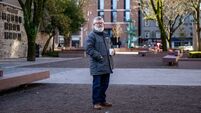Michael Moynihan: Knowing where to look for Cork’s hidden literary neighbourhoods

The Church of St. Anne, Shandon, Cork and The Cathedral of St. Mary and St. Anne (aka The North Chapel, The North Cathedral) in bright sunshine on the northside of Cork City. Picture: Larry Cummins.
Greetings and salutations this morning to Professor Chris Morash, who works with a pretty unwieldy title — Seamus Heaney Professor of Irish Writing — but overcame that lengthy handle to deliver a very enjoyable lecture recently.
Prof Morash gave the Fourth Annual Dublin Unesco City of Literature Lecture 2022 (again with the cumbersome titles) but his subject overcame any potential reticence from this viewer: Dublin’s Hidden Literary Neighbourhoods.
You can see the lecture here for yourself, and it’s well worth your attention.
I was particularly taken by the early diversion not to the great Georgian streetscapes of the capital, or the pubs frequented by Flann O’Brien now lost to the mists of time, but to a more notional area, such as the parts on or adjacent to the Grand Canal. This included the bedsit once occupied by Patrick Kavanagh, though of course in the Ireland of today the bedsit itself is probably a relic of ancient history on a par with those Georgian streetscapes. More of that on another occasion, though.
There’s a message in that ‘Hidden’ lurking in the lecture title, of course; a suggestion that where there are hidden literary neighbourhoods, then there must be ones in plain sight.
This is true in Dublin: the work of James Joyce scholars and enthusiasts mean much of the city can be interpreted and strolled as a kind of theme park, though with regrettably fewer bumper cars. You look to other large cities and a similar impulse arises. Paris and London can be quickly reduced to a book-lover’s map, while a quick glance at the website of the New York Public Library sees an even more detailed breakdown (Brooklyn: Greenpoint: The Astral by Kate Christensen; Brooklyn: Williamsburg: A Tree Grows in Brooklyn by Betty Smith, etc etc) It’s practically street by street.
Of course, regular readers can see where I’m heading here.
What about Cork’s hidden literary neighbourhoods?
Many of Cork’s areas are uniquely identified with particular writers, naturally enough. The area around Collins Barracks and down the Fever Hospital Steps: Frank O’Connor. Half Moon St in particular: Sean Ó Faoláin. The list goes on.
For all that, subtler readers can see the ghost of a neighbourhood in other works, the vague outlines of a zone, or rather its inhabitants. Rather than being named and trumpeted, this area pops up in some unexpected contexts but only if you know where to look.
I refer, of course, to my own home place of Blackpool, which has a ghostly literary presence. As long as you know where to look.
I mentioned Sean Ó Faoláin above, and many readers will be familiar from their school days with his great story , in which a successful civil servant recounts his life story to a fellow traveller as they return to their native Cork on the evening train from Dublin.
Towards the end of the story the narrator sees a change in the civil servant.
“His eyes lit up. I looked sideways to see what had arrested him. It was the first lights of Cork, and, mingling with the smoke over the roofs, the January night. Behind the violet hills the last cinder of the sun made a saffron horizon. As the train roared into the tunnel we could see children playing in the streets below the steep embankment, and he was staring at them and I must have imagined that I heard their happy shouts. Then the tunnel opened and swallowed us.”
The streets in question, the ones below the steep embankment, are the likes of Spring Lane and Dublin St, the thoroughfares which the train frowns down on as it’s coming and going.
If someone on that train looked right instead of left they would be gazing up the long slope of Dublin Hill, which features in the best poem written about Cork’s northside — Theo Dorgan’s ‘A Nocturne for Blackpool’ (“a truck heading for Mallow roars, changing gear on a hill/The electric hum of the brewery whines, then drops in pitch —/ground bass for the nocturne of Blackpool.”)
It’s always been interesting to me that in neither the poem nor the story the authors explicitly identify this part of Cork, though in his poem Dorgan focuses on the parts of Blackpool that Ó Faoláin described as well: North Chapel, The Assumption, Farranferris, and Blackpool, the mass of the church in stone rears like rock from the sea but the interlaced lanes flick with submarine life older than priests can, or want to, understand.
Maybe this is why Blackpool has never taken off as a literary neighbourhood in the classic style — because outsiders find it so hard to understand us.
This isn’t a notion confined to the inhabitants of Linn Dubh, but we’re one of the few tribes within Cork to have our language formally explained in print.
When DP Long wrote about Blackpool for the Glen Rovers history 50 years ago he offered a handy primer for some indigenous phrases. Surely even readers who are strangers to Pouraddy can understand the Blackpool expression being explained here to the uninitiated?
“In those two words there is summed up all the congratulations, the praise, the appreciation, for a very successful performance, and a strong encouragement to continue to do likewise. The phrase may be translated thus: ‘I have no doubts about your ability, you, who are still only a boy.” (Translation available on request.)
The definitive establishment of Blackpool as a hidden literary neighbourhood comes in one of James Joyce’s earlier works, however.
Early on in , Stephen Dedalus and his father Simon go to Cork — again on the train, though they’re half-asleep when the locomotive passes over Blackpool — and revisit Simon’s old stomping grounds around the city.
While in a pub in the city Simon insists he’s as good a man as his son, despite their age difference: “I’ll sing a tenor song against him or I’ll vault a five-barred gate against him or I’ll run with him after the hounds across the country as I did thirty years ago along with the Kerry Boy and the best man for it.”
For the alert Blackpudlian, there’s a strong echo immediately here of an old song from the neighbourhood: “Blackpool I dread ye/God knows ye’re never bate/For a hunter or a hurler/Or a hound at a five-barred gate.” Who influenced who here? Was the ballad-maker fresh from reading A Portrait? Did Joyce reach back through his memory to a snatch of song heard on a long-ago visit to Cork?
The great man famously said that it was one of his aims to put enough puzzles and enigmas into his work to keep professors busy for centuries trying to work them all out.
It’s oddly comforting to think an old ballad from Cork’s hidden literary neighbourhood holds the key to understanding just one of those puzzles, giving scholars of Joyce’s work all over the world a headache as they try to work out what exactly a five-barred gate is.












